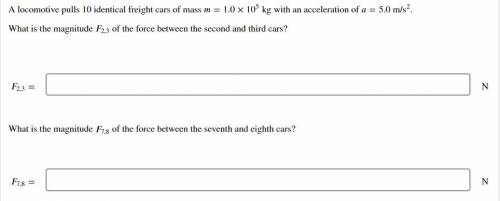
Physics, 05.02.2022 09:00 angelasnipes51orfryq
A locomotive pulls 10 identical freight cars of mass =1.0 × 10^5 kg with an acceleration of = 5.0 m/s2.
What is the magnitude 2,3 of the force between the second and third cars?
What is the magnitude 7,8 of the force between the seventh and eighth cars?


Answers: 2


Other questions on the subject: Physics

Physics, 21.06.2019 17:30, stryjker
The ballistic pendulum was invented in 1742 by english mathematician benjamin robins. it consists of an initially stationary pendulum that moves after being struck by a bullet, and it is used to measure the original velocity of the bullet. the known variables are the bullet's mass m, the pendulum's mass m, and the height to which the block and bullet swing, determined by the length of the pendulum l and final angle θ. two principles of physics are necessary to solve for the bullet's original velocity. what are these principles? conservation of momentum and newton's third law conservation of energy and conservation of angular momentum grade summary deductions 0% potential 100% conservation of momentum and newton's second law. newton's second law and conservation of angular momentum. conservation of energy and newton's third law conservation of momentum and conservation of angular momentum. conservation of momentum and conservation of energy conservation of energy and newton's second law.
Answers: 2


Physics, 22.06.2019 01:30, madelyncross24
Use the frequency histogram to complete the following parts. ​(a) identify the class with the​ greatest, and the class with the​ least, relative frequency. ​(b) estimate the greatest and least relative frequencies. ​(c) describe any patterns with the data. female fibula lengths 30.5 31.5 32.5 33.5 34.5 35.5 36.5 37.5 38.5 39.5 0 0.05 0.1 0.15 0.2 0.25 length (in centimeters) relative frequency a histogram titled "female fibula lengths" has a horizontal axis labeled "length in centimeters" from 30.5 to 39.5 in increments of 1 and a vertical axis labeled "relative frequency" from 0 to 0.25 in increments of 0.05. the histogram contains vertical bars of width 1, where one vertical bar is centered over each of the horizontal axis tick marks. the approximate heights of the vertical bars are listed as follows, where the label is listed first and the approximate height is listed second: 30.5, 0.02; 31.5, 0.04; 32.5, 0.05; 33.5, 0.13; 34.5, 0.22; 35.5, 0.25; 36.5, 0.13; 37.5, 0.06; 38.5, 0.09; 39.5, 0.01. ​(a) the class with the greatest relative frequency is nothing to nothing centimeters. ​(type integers or decimals. do not round. use ascending​ order.)
Answers: 3

Physics, 22.06.2019 03:00, chastynpatrick
If it takes a planet 2.8 x 10^8 s to orbit a star with a mass of 6.2 x 10^30 kg what is the average distance between the planet and the star
Answers: 3
You know the right answer?
A locomotive pulls 10 identical freight cars of mass =1.0 × 10^5 kg with an acceleration of = 5.0 m/...
Questions in other subjects:



English, 04.01.2020 21:31


History, 04.01.2020 21:31







